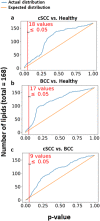High-throughput lipidomic profiles sampled with electroporation-based biopsy differentiate healthy skin, cutaneous squamous cell carcinoma, and basal cell carcinoma
- PMID: 38721854
- PMCID: PMC11079884
- DOI: 10.1111/srt.13706
High-throughput lipidomic profiles sampled with electroporation-based biopsy differentiate healthy skin, cutaneous squamous cell carcinoma, and basal cell carcinoma
Abstract
Background: The incidence rates of cutaneous squamous cell carcinoma (cSCC) and basal cell carcinoma (BCC) skin cancers are rising, while the current diagnostic process is time-consuming. We describe the development of a novel approach to high-throughput sampling of tissue lipids using electroporation-based biopsy, termed e-biopsy. We report on the ability of the e-biopsy technique to harvest large amounts of lipids from human skin samples.
Materials and methods: Here, 168 lipids were reliably identified from 12 patients providing a total of 13 samples. The extracted lipids were profiled with ultra-performance liquid chromatography and tandem mass spectrometry (UPLC-MS-MS) providing cSCC, BCC, and healthy skin lipidomic profiles.
Results: Comparative analysis identified 27 differentially expressed lipids (p < 0.05). The general profile trend is low diglycerides in both cSCC and BCC, high phospholipids in BCC, and high lyso-phospholipids in cSCC compared to healthy skin tissue samples.
Conclusion: The results contribute to the growing body of knowledge that can potentially lead to novel insights into these skin cancers and demonstrate the potential of the e-biopsy technique for the analysis of lipidomic profiles of human skin tissues.
Keywords: basal cell carcinoma; cutaneous squamous cell carcinoma; electroporation‐based biopsy; e‐biopsy; high‐throughput lipidomics; lipidomic profiles.
© 2024 The Authors. Skin Research and Technology published by John Wiley & Sons Ltd.
Conflict of interest statement
Edward Vitkin, Avshalom Shalom, Julia Wise, Alexander Golberg, and Zohar Yakhini are consultants to Elsy Medical.
Figures



Similar articles
-
High-Throughput Metabolomic Profiling of Skin Lesions: Comparative Study of Cutaneous Squamous Cell Carcinoma, Basal Cell Carcinoma, and Normal Skin Via e-Biopsy Sampling.Cell Mol Bioeng. 2025 Apr 3;18(2):185-195. doi: 10.1007/s12195-025-00846-1. eCollection 2025 Apr. Cell Mol Bioeng. 2025. PMID: 40290108 Free PMC article.
-
Differential Expression Analysis of Cutaneous Squamous Cell Carcinoma and Basal Cell Carcinoma Proteomic Profiles Sampled with Electroporation-Based Biopsy.JID Innov. 2024 Aug 3;4(6):100304. doi: 10.1016/j.xjidi.2024.100304. eCollection 2024 Nov. JID Innov. 2024. PMID: 39497856 Free PMC article.
-
GLUT-1 Expression in Cutaneous Basal and Squamous Cell Carcinomas.Int J Surg Pathol. 2015 Sep;23(6):447-53. doi: 10.1177/1066896915589968. Epub 2015 Jun 19. Int J Surg Pathol. 2015. PMID: 26092229
-
Genome-wide association studies and polygenic risk scores for skin cancer: clinically useful yet?Br J Dermatol. 2019 Dec;181(6):1146-1155. doi: 10.1111/bjd.17917. Epub 2019 Jul 7. Br J Dermatol. 2019. PMID: 30908599 Free PMC article. Review.
-
Updates in the Management of Advanced Nonmelanoma Skin Cancer.Surg Oncol Clin N Am. 2024 Oct;33(4):723-733. doi: 10.1016/j.soc.2024.04.006. Epub 2024 Jun 5. Surg Oncol Clin N Am. 2024. PMID: 39244290 Review.
Cited by
-
High-Throughput Metabolomic Profiling of Skin Lesions: Comparative Study of Cutaneous Squamous Cell Carcinoma, Basal Cell Carcinoma, and Normal Skin Via e-Biopsy Sampling.Cell Mol Bioeng. 2025 Apr 3;18(2):185-195. doi: 10.1007/s12195-025-00846-1. eCollection 2025 Apr. Cell Mol Bioeng. 2025. PMID: 40290108 Free PMC article.
References
-
- Lim HW, Collins SAB, Resneck JS, et al. The burden of skin disease in the United States. J Am Acad Dermatol. 2017;76(5):958‐972.e2. e2. - PubMed
-
- Zhang W, Zeng W, Jiang A, et al. Global, regional and national incidence, mortality and disability‐adjusted life‐years of skin cancers and trend analysis from 1990 to 2019: An analysis of the Global Burden of Disease Study 2019. Cancer Med. 2021;10(14):4905‐4922. https://onlinelibrary.wiley.com/doi/full/10.1002/cam4.4046 - DOI - PMC - PubMed
-
- Perera E, Gnaneswaran N, Staines C, Win AK, Sinclair R. Incidence and prevalence of non‐melanoma skin cancer in Australia: a systematic review. Australas J Dermatol. 2015;56(4):258‐267. https://onlinelibrary.wiley.com/doi/full/10.1111/ajd.12282 - DOI - PubMed
-
- Tang E, Fung K, Chan AW. Incidence and mortality rates of keratinocyte carcinoma from 1998–2017: a population‐based study of sex differences in Ontario, Canada. CMAJ. 2021;193(39):E1516‐E1524. https://www.cmaj.ca/content/193/39/E1516 - PMC - PubMed
-
- Rogers HW, Weinstock MA, Feldman SR, Coldiron BM. Incidence estimate of nonmelanoma skin cancer (keratinocyte carcinomas) in the US population, 2012. JAMA Dermatol. 2015;151(10):1081‐1086. https://jamanetwork.com/journals/jamadermatology/fullarticle/2281227 - PubMed
MeSH terms
Substances
Grants and funding
LinkOut - more resources
Full Text Sources
Medical

